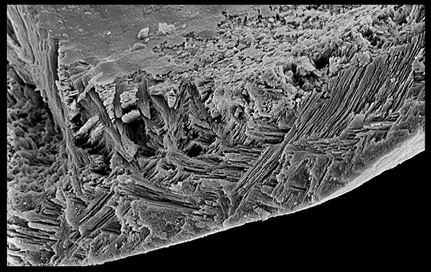Late Paleozoic larval paleobiology
Section Fossil Molluscs
Gastropod shells reflect ontogeny to a high degree. Even in fossil species, the analysis of the morphology and the dimensions of early ontogenetic shells (protoconchs) allow to infer whether a plankton feeding larval stage was present or not. However, protoconchs are rarely preserved and have been primarily used for taxonomy and phylogenetics. However, the information content of protoconchs is much higher.
Planktotrophic larval shells allow to assess paleo-productivity and planktonic food chains. Moreover, heterochronic processes can be recognized which play an important role in evolution. We have superbly preserved Carboniferous gastropods at hand from the Buckhorn Asphalt (Oklahoma, U.S.A.) and other Upper Carboniferous localities in the U.S.A. In the case of the Buckhorn Asphalt, an oils migrated synsedimentary into the Upper Carboniferous deposits and sealed the mollusc shells. Thus, they are preserved in their original aragonitic composition with microstructures. This material facilitates a reconstruction of Late Paleozoic ecosystems and planktonic food chains including larval ecology of marine invertebrates.
An analysis of the evolution of gastropod larvae showed that openly coiled larval shells were dominant in the Early Paleozoic and that this morphology has been increasingly abandoned during the Paleozoic. Cambrian molluscs probably had a non planktotrophic early ontogeny and planktotrophy evolved at the Cambrian/Ordovician boundary.

Planktotrophic caenogastropod larval shell from the Buckhorn Asphalt (Upper Carboniferous, Pennsylvanian, U.S.A.). 
Aragonitic crossed-lamellar shell structure from the Buckhorn Asphalt; preservation of this structure is very rare in Paleozoic deposits; width c. 0.2 mm. 
Thin section of nautilid with cameral deposits from the Buckhorn Asphalt; the brown colors derive from the asphalt impregnation. 
Protoconch measurements suggest that there were no planktotrophic mollusc larvae in the Cambrian and that planktotrophy evolved at the transition to the Ordovician (from Nützel et al. 2006, Evolution & Development; copyright Blackwell Publishing).
Contact: Prof. Dr. Alexander Nützel
Working group
Barbara Seuß, Institut für Paläontologie, Universität Erlangen
André Freiwald, Institut für Paläontologie, Universität Erlangen
Cooperations
Royal, H. Mapes, Department of Geological Sciences, Ohio University, Athens 45701, U.S.A.
Thomas Yancey, Texas A&M University, Geology & Geophysics, College Station,
Texas, TX 77843-3115
Dieter Korn, Museum für Naturkunde, Humboldt Universität Berlin
Jiri Frýda, Czech Geological, Prag, Czech Republic
http://nts1.cgu.cz/portal/page/portal/shared/j/jiri.fryda
Publications
Seuss, B., Nützel, A., Mapes, R. H., Yancey, T. E. 2009. Facies and fauna of the Pennsylvanian Buckhorn Asphalt Quarry deposit: a review and new data on an important Palaeozoic fossil Lagerstätte with aragonite preservation. Facies 55: 609-645, DOI 10.1007/s10347-009-0181-9.
Mapes, R. H. & Nützel, A. 2009. Where did Upper Paleozoic cephalopods lay their eggs? – Evidence from cephalopod embryos and gastropod and pelecypod veliger larvae. Lethaia 42: 341–356, DOI: 10.1111/j.1502-3931.2008.00141.x
Wisshak, M., Seuß, B. & Nützel, A. 2008. Evolutionary implications of an exceptionally preserved Carboniferous microboring assemblage in the Buckhorn Asphalt Lagerstätte (Oklahoma, USA). In: Wisshak M, Tapanila L (eds) Current Developments in Bioerosion. Springer-Verlag, Berlin Heidelberg, 21-54.
Servais, T., Lehnert, O., Li, J., Mullins, G.L., Munnecke, A., Nützel, A. & Vecoli, M. 2008. The Ordovician Biodiversification: revolution in the oceanic trophic chain. Lethaia 41: 99-109.
Nützel, A., Frýda, J., Yancey, T. E. & Anderson, J. R. 2007. Larval shells of Late Palaeozoic naticopsid gastropods (Neritopsoidea: Neritimorpha) with a discussion of the early neritimorph evolution. Paläontologische Zeitschrift 81: 213–228.
Lehnert, O., Vecoli, M., Servais, T. & Nützel, A. 2007. Did plankton evolution trigger the Ordovician diversifications? Acta Palaeontologica Sinica 46: 262-268.
Nützel, A., Lehnert, O. & Frýda, J. 2007. Origin of planktotrophy – evidence from early molluscs: A response to Freeman and Lundelius. Evolution & Development 9: 313-318.
Nützel, A., Lehnert, O. & Frýda, J. 2006. Origin of planktotrophy – evidence from early molluscs. Evolution & Development 8: 325-330.
Nützel, A. & Frýda, J. 2003. Paleozoic plankton revolution: Evidence from early gastropod ontogeny. Geology 31: 829-831.
Bandel, K., Nützel, A. & Yancey, T. E. 2002. Larval shells and shell microstructures of exceptionally well-preserved Late Carboniferous gastropods from the Buckhorn Asphalt deposit (Oklahoma, USA). Senckenbergiana letheae 82: 639-689.
Nützel, A. & Mapes, R. H. 2001. Larval and juvenile gastropods from a Carboniferous black shale: palaeoecology and implications for the evolution of the Gastropoda. Lethaia 34: 143-162.

